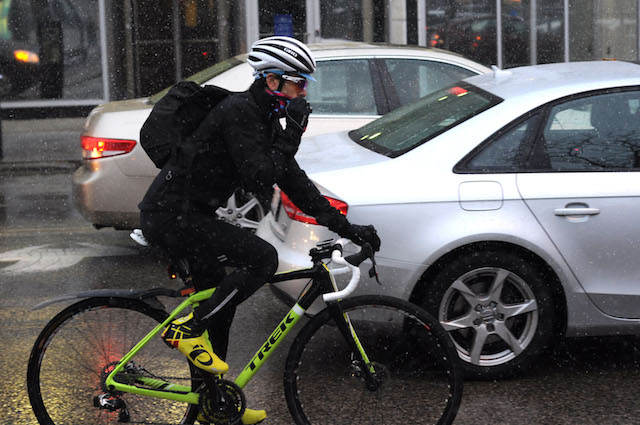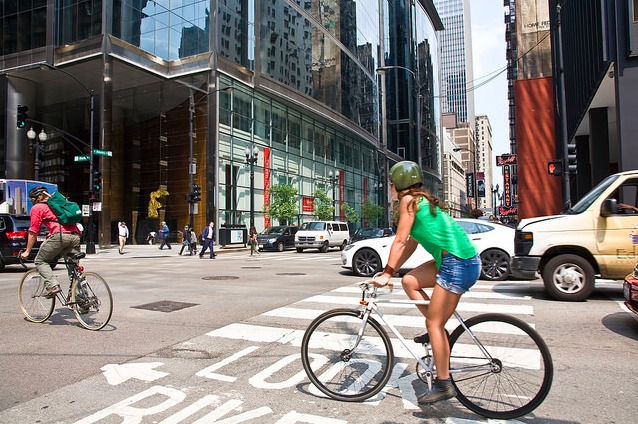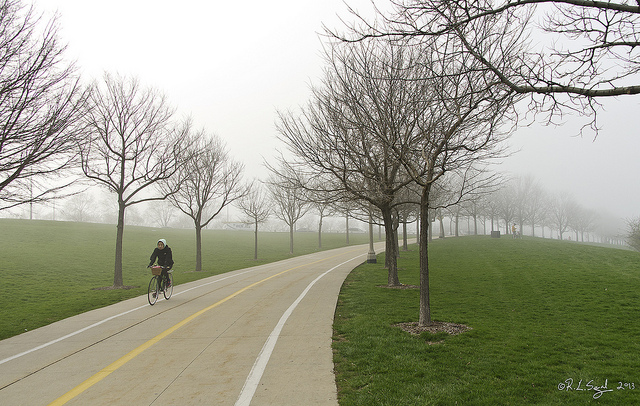A Beginner's Guide To Biking On The Mean Streets Of Chicago
By Chicagoist_Guest in News on Mar 25, 2016 8:00PM
As the snow and ice of winter fade into memory, these first few weeks of spring in Chicago see a lot of bicyclists getting back on the roads. For those out for the first time, it can be overwhelming and a little bit scary. Here are some tips from a longtime Chicago bicyclist to help you get out on the road in a safe and low-anxiety manner.
By Michael Una

Thousands of bicyclists take to Lake Shore Drive every Memorial Day weekend for the MB Financial Bank Bike the Drive. (Photo credit: iitichai)
First, you want to get your bicycle into riding condition. A properly adjusted and well-maintained bicycle is your friend, and it’s easier than you think to do it yourself. Plus, your body will thank you. Here are the basics, whether you’re on your own bike or a Divvy, plus a map of local bike shops that can help you along the way.
Seat height: If your hips dip to either side while pedaling, the seat is too tall and will cause lower back pain. Keep those hips square! If your thighs get crampy, the seat is too low and you won’t be using your full strength. You’ll probably need to adjust it a few times and ride up and down the block until it feels right.
Check the brakes: You should have some amount of control on whether to slow down or stop entirely—if the brakes just slam on, that’s bad, and you should loosen it a small amount. Every time you get on your bike, ride a short distance and then check the response of the brakes. Yes, we mean every single time you ride.
Inflate the tires to their recommended pressure: Too low and you’ll spend a lot more energy feeling like you’re riding through quicksand. Too high and you’ll blow a tube. Pretty much every neighborhood bike shop has a free pump for you to use if you don’t have one. You will need to do this at least once a month.
Oil the chain: WD-40, silicone spray, racing grease, whatever. A rusty chain can slip while you’re pedaling, and that can cause falls and crashes. And besides, it sounds horrendous to ride with one.
Get a real lock: Use a newer, U-type lock to secure your bike—and by your bike, we mean one of the tubes that makes up its main frame and the front wheel. A thin chain or cable is too easily defeated by robbers, even if you only leave your bike locked up for a short time. If you park your bike out overnight, you should consider using both a U-lock and a cable for each of the wheels. But in most situations, a U-lock big enough to grab the front wheel and frame and attach to an immovable object will work well—anything less, and your asking for someone to walk away with your front tire, or worse, the entire frame.
Photo credit: Chuck Sudo/Chicagoist
Gear up: Once your bicycle is good to go, take a quick look at your clothing. You probably want to roll up up that right pant leg so you don’t get chain grease on it. Tighten up your shoelaces and the straps of your bag a little bit so they don’t get caught or swing around. Make sure your helmet straps are snug. Pro tip: it really sucks to have a piece of dry dust blown into your eye when you’re biking down a busy street—get a pair of clear safety glasses for riding, you’ll be glad you did.
Wear a helmet: Just do it. Your momma will thank you.
Don’t wear headphones: When you first start riding in traffic, the sounds around you can be loud and totally overwhelming. It’s tempting to want to put on some music to lower your anxiety and make the experience more enjoyable. Don’t. Your eyes only see where they’re pointing, whereas your ears take in sound in three dimensions all around you. If you’re wearing headphones, you can’t hear cars coming up behind you. That’s bad. Which brings us to:
Pay attention to everything going on around you: In addition to the big metal death machines (a.k.a. cars) hurtling in all directions, there are potholes, construction zones, little dogs, loose piles of gravel, puddles of unknown depth, other bicyclists, hoverboards, and a thousand other things that can cause serious injury or death. Your job is to see them all coming in advance and plan or react your way around them. Try not to space out, and ride at a speed that gives you enough time to react for your age, level of fitness, and sensory perception.
Plan your route: Before you start riding, take a look at Google maps—it has a bicycle option that will route you away from heavy traffic streets and onto ones with wider bike lanes. Either commit the route to memory or crank up the turn-by-turn volume and put it in your front breast pocket. Regardless, stay off Western and Ashland at all costs- they’re both heinous. And Lake Shore Drive. And Michigan Avenue. For even more detailed help, look to the city's comprehensive bike lane map.
Watch for doors: Even in a bike lane, hazards abound. Hang to the left in a bike lane, to give yourself extra room in case someone in a parked car opens a door without looking. Broken collarbones are no fun.
Buses are not actually trying to kill you, but it sure seems like it
: Buses will pass you and then pull sharply to the right and stop, totally cutting you off and forcing you to stop quickly before getting pinched between the bus and the curb. They do it all the time. It sucks, and there is basically nothing you can do about it when it’s happening. Buses also will pull out to the left as you’re trying to pass, forcing you into traffic, and it’s scary as hell. Over the distance of a city block, buses are about the same speed as a bicycle, so you and a bus might get locked into a “Do-Si-Do” of Death where the same near-accident happens multiple times. Consider slowing down or speeding up to get out of the danger zone.
You may be sensing a pattern here: bicycles and buses don’t mix well, so give them lots of space.
Slow down when “shooting the gauntlet”: If there’s a line of parked cars on your right, and a line of cars waiting at a red light on your left, you’ve got nowhere to go when something enters your space. So slow down and take it at a slow cruise—that’s a red light in front of you anyway.
Don’t shoal: If you come up to a red light and there are other bikers in front of you, don’t crowd in front of them. That makes it harder for everyone to get started when the light changes, and chances are, they’re in front of you because they’re faster than you. If they’re going slower than you, just pass them after the intersection. Don’t shoal. It’s a jerk move.
Yell if you gotta: You will encounter pedestrians and drivers who aren’t paying attention, possibly endangering you or themselves. It’s totally ok to shout a quick heads-up at the top of your lungs, like “HEY” or “YO” or “WATCH OUT”. It’s not OK to subsequently yell at them for ten minutes about how they need to respect bikers or whatever because you’re all full of adrenaline and need to do something about it. Avoid the collision and move on with your life; ain’t nobody got time for curbside rage.

A biker riding through traffic (Photo by Christopher Walljasper/Chicagoist)
Follow the rules of the road—they apply to you, too: The official rules say to behave like a car; full stops at stop signs, wait at red lights, all that. Most bicyclists agree that this is true when there’s a lot of traffic, and silly when it’s 2 a.m. and there’s no cars around. Your behavior will likely be some gray area between these two extremes. My advice is to keep in mind these two principles:
*Be predictable. If everyone else on the road can reasonably predict what you’re about to do, they can plan for it and probably won’t run you over by accident. So keep your behavior within predictable bounds when others are around.
*Don’t interrupt flow. If anyone has to suddenly swerve or slam on their brakes because of something you’re doing, you’re doing it wrong.
If you can satisfy both these conditions, you’ll be just fine, and so will everyone around you.
Take it easy and you’ll get where you’re going: Bicycling is the cheapest, healthiest, and usually the fastest way to get around the city. And it’s fun, if you can avoid getting smashed by a bus or road raging at an SUV crowding the bike lane. So just take it down a notch, yeah? You’ll get there.
Related stories:
*Why you should ride with a bike light.
*5 key mistakes to avoid after a bike crash.
*Chicagoist's bike etiquette tips.
*Chicagoist's guide to biking through winter.

